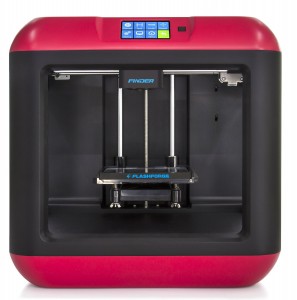FlashForge Finder 3D Printer Review
The FlashForge Finder is a user-friendly, entry-level printer designed for classrooms and homes. This very compact 3D printer has a very clean design with cables concealed from sight within the plastic alloy body so that the printer is more or less plug-and-play. For safety, all the heated elements are protected from touch, and the printing material is non-toxic PLA.
The Finder comes with:
- Quick Start Guide
- 1 roll of 600 g PLA filament
- 1 sheet of platform sticker, installed on the glass plate before packing.
- Power cable
- USB cable
- Filament guide tube
- USB Stick (contains electronic user guide, FlashPrint software)
The print resolution over the Finder’s 5.5 x 5.5 x 5.5 in build volume is 11 microns in X and Y positioning precision while the layer thickness ranges from 100 to 500 microns and the print speed ranges from 40 to 200 mm/sec. The glass printer bed slides in to enable easy loading and unloading of the 3D prints, and covering the glass surface with blue painter’s tape helps with filament adhesion to the print bed. Being unheated, the Finder can only support PLA filaments. The proprietary filament storage tells whether the filament is actually extruding or not, giving you the ability to start or stop the print.
This 3D printer comes packed with next generation 3D printing technology. The user interface is via the same colorful, intuitive LCD panel as on the FlashForge Dreamer. Booting up the printer brings up buttons for print, preheat and tools. Print brings up the options for the USB interface or the onboard memory storage that includes a test print frog figure. Tools brings up a submenu of options that includes loading and unloading the filament and auto-leveling the print bed.
The auto-leveling feature makes it easy to calibrate the 3D printer bed. You are directed to tighten or loosen a print bed support screw until a beeper barely sounds at the correctly leveled position, then repeat the process at the next screw location. The calibration process corrects for slight out-of-roundness, warping issues, imperfections on the PLA parts and difficulty in removal of parts.
4 GB of onboard memory allows 3D printing files to be stored onboard the Finder once they have been loaded with the USB cable, after which the computer can be untethered from the printer. The 3D printing files can also be sent through Wifi, allowing even more convenience in the locations of the Finder and the computer. The FlashPrint software bundled with the Finder has an interface that is simple to use.
FlashForge has focussed on improving the extrusion process so that the Finder has a new MK10 brass nozzle and PTFE thermal barrier guide tube. The noise level is also very low, much lower than the Dreamer, as low as 50 dB, according to the manufacturer.
For home, classroom or general use this cost-effective, entry-level printer is an excellent choice. For applications that require ABS, PLA, and other filament materials, the more-advanced FlashForge Creator Pro would make more sense.
Technical Specifications
- Build Volume: 5.5 L in X 5.5 W in X 5.5 H in
- Layer Thickness: 100 microns~500 microns
- Positioning Precision: 11 microns on X and Y and 2.5 microns on Z
- Nozzle Diameter: 0.4 mm
- Filament Diameter: 1.75 mm
- Printing Technology: FDM (Fused Deposition Modeling)
- Printing material: PLA only
- Frame & Body: Plastic Alloy
- Extruders: One
- Product Dimension: 16.5 in x 16.5 in x 16.5 in
- Shipping Dimension: 19.7 in x 19.7 in x 19.7 in
- Product Weight: 44 lbs
- Shipping Weight: 62 lbs
- Software: FlashPrint
- File Type: STL, OBJ
- Connectivity: Wi-Fi, USB Cable, and USB Stick
- OS Support: Windows 7/8/Vista, Mac OS X
- Language: English / Chinese
- AC Input: 115V ~ 230 V, 50 Hz ~ 60 Hz, 100 W
